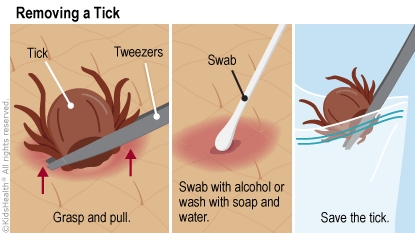Corporate Circle Members
40 Exchange Place, Suite 1902, New York, NY 10005
Phone
917.746.8300
Members Only
877.662.7627
© 2020 NAPNAP, Inc. All rights Reserved
You just found a tick on your child! What should you do?
First, don't panic. It's true that Lyme disease is the most common tick-borne disease in the United States. But your child's risk of developing Lyme disease after being bitten by a tick is very low.
To be safe, though, you'll want to remove the tick as soon as possible. The risk of infection rises 24–48 hours after the tick attaches to the skin.
Step 1: Use tweezers to grasp the tick firmly at its head or mouth, next to the skin. Use a magnifying glass, if you have one, to see the tick clearly.
Step 2: Pull firmly and steadily until the tick lets go of the skin. Do not twist the tick or rock it from side to side. If part of the tick stays in the skin, don't worry. It will eventually come out on its own.

Step 3: Release the tick into a jar or zip-locked bag.
Step 4: Wash your hands and the site of the bite with soap and water.
Step 5: Swab the bite site with alcohol to disinfect the skin. Then, call your doctor, who might want to see the tick. Sometimes, doctors prescribe a preventive dose of antibiotics for kids at high risk for Lyme disease.
Note: Never use petroleum jelly or a hot match to kill and remove a tick. These methods don't get the tick off the skin, and can make it burrow deeper.
Call the doctor right away if your child has:
Other conditions can also cause these symptoms. But having your child seen early means that if it is Lyme disease, treatment can begin quickly.

© 1995- The Nemours Foundation. KidsHealth® is a registered trademark of The Nemours Foundation. All rights reserved.
Images sourced by The Nemours Foundation and Getty Images.
New UsersCreate a User AccountBecome a Member |
Forgot PasswordForgot your password? Click here |
